30 Email Marketing Interview Questions For 2025
If you’re preparing for your next marketing role, getting familiar with email marketing interview questions is a game-changer. From technical know-how to strategic thinking, interviewers want to know how you create emails that drive real results. Whether you’re just starting out or looking to step up, understanding what questions to expect (and how to answer them confidently) can set you apart.
This guide will explore you through the top 30 email marketing interview questions so you can walk into your interview feeling ready and self-assured.
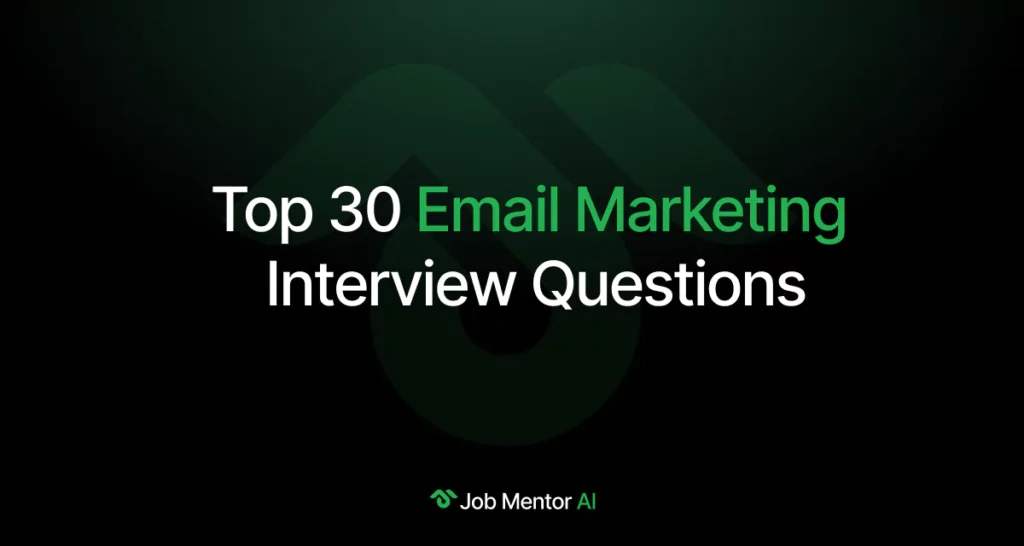
Basic Email Marketing Interview Questions
1. What is email marketing, and why is it important?
2. What are the types of email campaigns?
3. How often should you send marketing emails?
4. What is a mailing list, and how do you build one?
5. What’s the difference between B2B and B2C email marketing?
Technical Email Marketing Interview Questions
1. Which email marketing tools have you used (like Mailchimp, HubSpot, etc.)?
2. How do you create an HTML email?
3. What is email deliverability and how can it be improved?
4. How do you avoid emails going to the spam folder?
5. What are UTM parameters, and how are they used in email campaigns?
Strategy-Based Email Marketing Interview Questions
1. How do you segment an email list effectively?
2. How do you personalise email content?
3. What’s your approach to creating a successful email campaign from scratch?
4. How do you decide the best time and day to send an email?
5. How do you re-engage inactive subscribers?
Behavioural and Situational Email Marketing Interview Questions
1. Describe a time when an email campaign didn’t perform well. What did you do?
2. Have you ever had to deal with a high unsubscribe rate? How did you handle it?
3. Tell us about a successful campaign you ran and what made it work.
4. How do you manage deadlines when handling multiple campaigns?
5. How do you handle negative feedback from an email recipient?
Metrics and KPIs Email Marketing Interview Questions
1. What are the key metrics you track in an email campaign?
2. What’s a good open rate and click-through rate?
3. How do you calculate email ROI (Return on Investment)?
4. What is a bounce rate and what are its types?
5. How do you track conversions from email campaigns?
A/B Testing and Optimization Email Marketing Interview Questions
1. What is A/B testing in email marketing?
2. What elements can be tested in an email?
3. How do you decide what to test in a campaign?
4. What tools do you use for A/B testing?
5. How do you analyse the results of an A/B test?
Basic Email Marketing Interview Questions
Interviewers often start with basic email marketing interview questions to check your understanding of foundational concepts. They might ask how to build an email list, what makes a subject line effective, or how to stay compliant with privacy laws. These questions set the tone, so it’s important to show that you’ve got a solid grasp on email marketing essentials.
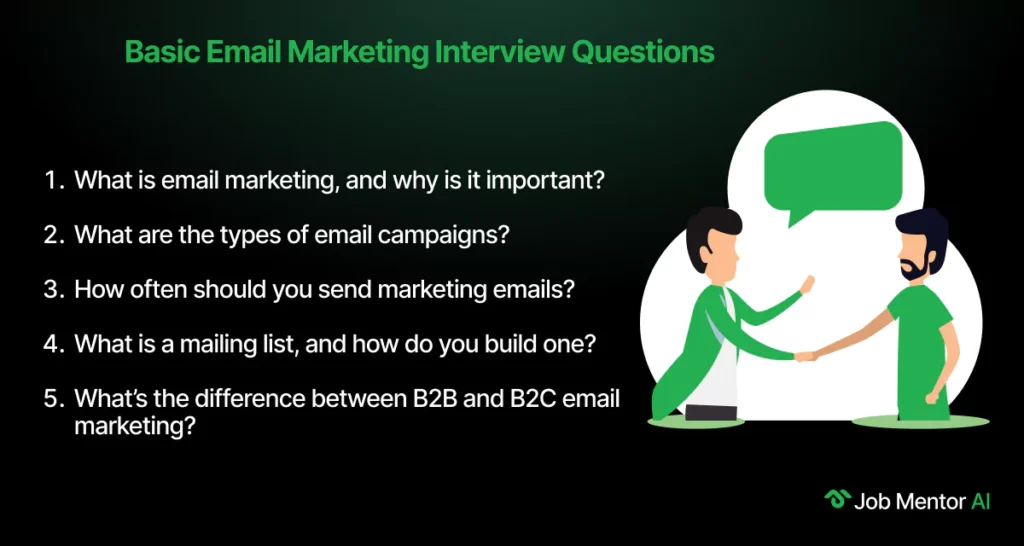
1. What is email marketing, and why is it important?
Email marketing is a digital strategy where businesses send emails to customers and prospects. It’s important because it helps build direct relationships, drive sales, share updates, and nurture leads. It’s also cost-effective and gives a high return on investment compared to other channels.
2. What are the types of email campaigns?
Common types include:
- Newsletters to keep subscribers informed.
- Promotional emails for offers and product launches.
- Transactional emails like order confirmations or shipping updates.
- Welcome emails to greet new subscribers.
- Re-engagement emails to connect with inactive users.
3. How often should you send marketing emails?
The ideal frequency depends on your audience and goals. Weekly or bi-weekly emails are common. Too many can cause unsubscribes, while too few can lead to low engagement. Testing different frequencies helps find what works best.
4. What is a mailing list, and how do you build one?
A mailing list is a collection of email addresses from people who have opted in to receive communication from you. You can build it through sign-up forms on your website, social media, events, or by offering freebies like eBooks or discounts in exchange for email addresses.
5. What’s the difference between B2B and B2C email marketing?
- B2B (Business-to-Business) emails focus on logic, value, and return on investment. They often have longer buying cycles and need more nurturing.
- B2C (Business-to-Consumer) emails are more emotional and sales-driven. They aim to create excitement and quick purchases, often using visuals and urgency.
Explore these helpful interview question guides
Technical Email Marketing Interview Questions
Technical email marketing interview questions focus on how well you handle tools like Mailchimp, HubSpot, or Klaviyo. You might be asked how to segment a list, build workflows, or automate campaigns. These questions are your chance to show that you’re not just creative but also comfortable working behind the scenes to make campaigns run smoothly.
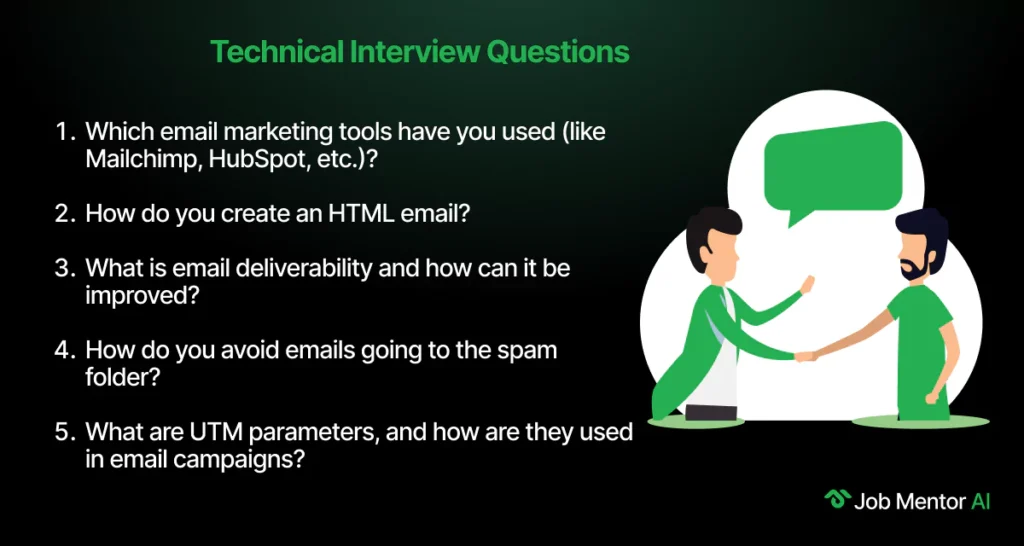
6. Which email marketing tools have you used (like Mailchimp, HubSpot, etc.)?
Common tools include Mailchimp, HubSpot, Constant Contact, ActiveCampaign, and Klaviyo. Each has features for automation, segmentation, templates, and analytics. Experience with these platforms shows you can manage and optimise campaigns effectively.
7. How do you create an HTML email?
HTML emails can be built using drag-and-drop editors or by coding manually. They include text, images, buttons, and links. Testing is important to make sure the email displays properly on all devices and clients (like Gmail or Outlook).
8. What is email deliverability and how can it be improved?
Email deliverability is the ability of your emails to reach subscribers’ inboxes. To improve it:
- Use verified sender domains.
- Avoid spammy content.
- Clean your list regularly.
- Use a reliable email service provider.
- Monitor bounce rates and complaints.
9. How do you avoid emails going to the spam folder?
We can avoid emails going to the spam folder by following this process:
- Avoid words like “Free” or “Act now” in the subject line.
- Use clean, professional HTML code.
- Always get permission before sending.
- Provide clear unsubscribe links.
Authenticate your domain (SPF, DKIM, DMARC).
10. What are UTM parameters, and how are they used in email campaigns?
UTM parameters are tags added to URLs to track campaign performance in tools like Google Analytics. For example:
https://example.com?utm_source=newsletter&utm_medium=email&utm_campaign=spring_sale
They help you measure which emails or links bring the most traffic or conversions.
Strategy-Based Email Marketing Interview Questions
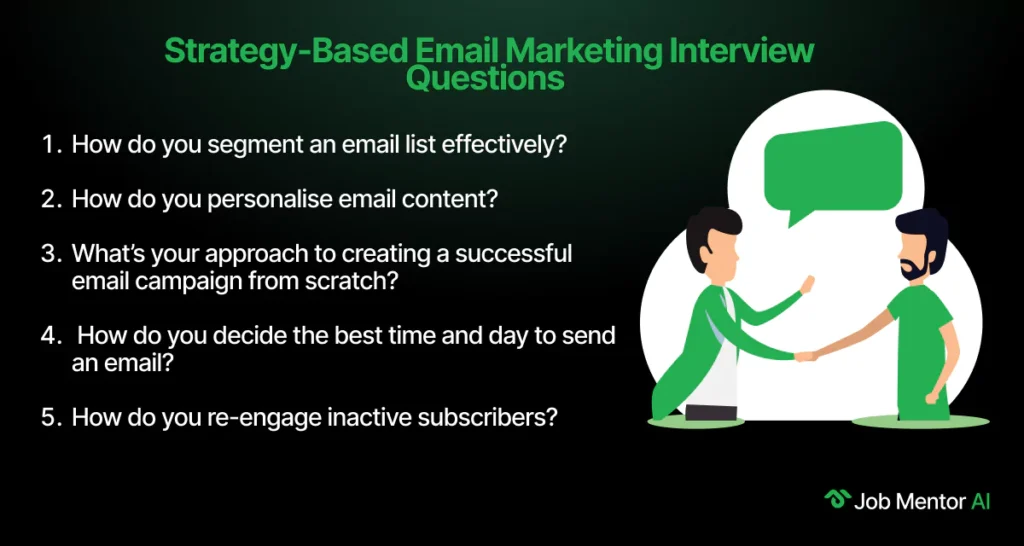
Strategy is where the magic happens. These types of email marketing interview questions explore how you plan campaigns, choose target segments, and time your emails. Interviewers want to see how your thinking aligns with business goals and customer behavior. Talk through your approach and show how you build an email strategy that actually converts.
11. How do you segment an email list effectively?
Segmentation means dividing your email list into smaller groups based on factors like:
- Demographics (age, gender, location)
- Purchase history
- Email engagement (opens/clicks)
- Preferences or behaviour on your website
Effective segmentation lets you send more relevant and personalised emails, which boosts engagement and reduces unsubscribes.
12. How do you personalise email content?
Personalisation can include using the subscriber’s name, recommending products based on their purchase history, or tailoring content to their interests. Tools like dynamic content blocks or conditional logic in email builders help create tailored messages. Personalisation increases open rates and click-throughs.
13. What’s your approach to creating a successful email campaign from scratch?
Some of the approaches to creating a successful email campaign from scratch are:
- Start by defining your goal (e.g, promote a product, drive sign-ups).
- Segment your audience.
- Write a catchy subject line and engaging email copy.
- Add visuals and a clear call-to-action (CTA).
- Test and preview your email.
- Schedule or send, then monitor performance.
- Optimise based on the results.
14. How do you decide the best time and day to send an email?
Use data from past campaigns or tools like A/B testing to identify when your audience is most active. For example, B2B emails often perform better during weekdays, while B2C can work on weekends or evenings. It depends on the target audience’s habits.
15. How do you re-engage inactive subscribers?
Use re-engagement campaigns with subject lines like “We miss you!” or offer a special deal to spark interest. You can also ask for feedback or offer to update their preferences. If they remain inactive, remove them from the list to maintain list health and deliverability.
Behavioural and Situational Email Marketing Interview Questions
Behavioral and situational email marketing interview questions dig into how you respond to real-life challenges. Interviewers may ask how you handled a failed campaign or improved engagement over time. Use specific examples to demonstrate your adaptability, problem-solving, and ability to learn from past experiences.
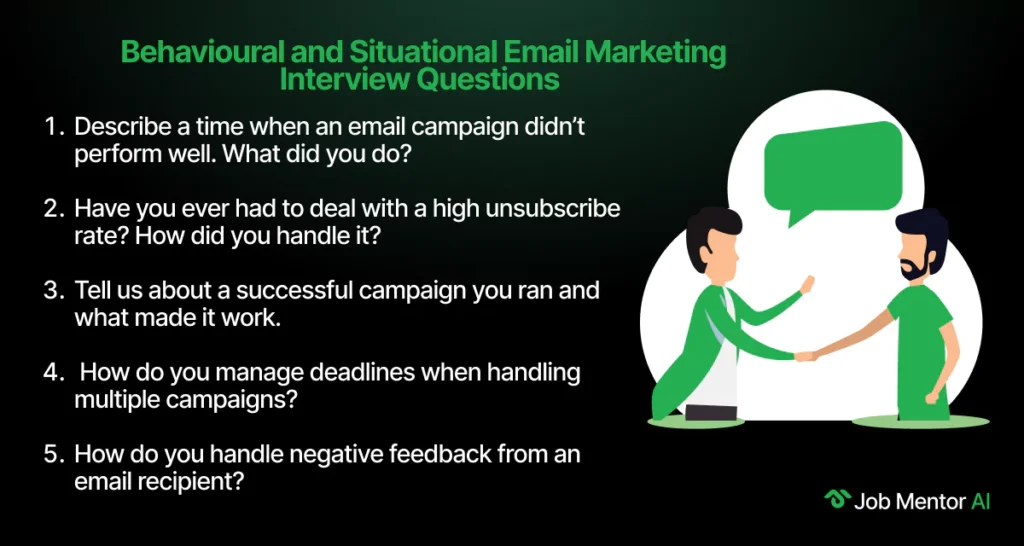
16. Describe a time when an email campaign didn’t perform well. What did you do?
I once sent a campaign with a low open rate. I reviewed the subject line and realised it lacked urgency. I tested new subject lines in future campaigns and saw improvement. I also cleaned the email list to remove unengaged users.”
17. Have you ever had to deal with a high unsubscribe rate? How did you handle it?
Yes. I checked the content, frequency, and targeting of the emails. I ran a survey to gather feedback and adjusted our content plan. Segmenting the audience more effectively helped reduce unsubscribes in future emails.
18. Tell us about a successful campaign you ran and what made it work.
Example: “I created a holiday promotion for a clothing brand with a strong subject line, product images, and a limited-time discount. The email had a 25% open rate and 12% click rate. Clear CTAS and good timing contributed to the campaign’s success.”
19. How do you manage deadlines when handling multiple campaigns?
I use project management tools like Trello or Asana and maintain a content calendar. I prioritise tasks based on deadlines and campaign importance, and always leave time for testing and approvals. Communication with the team is also key.
20. How do you handle negative feedback from an email recipient?
I always respond politely and thank them for their feedback. If they request to unsubscribe, I ensure it’s done immediately. If the issue is content-related, I review it and discuss improvements with the team. Constructive criticism helps improve future campaigns.
Metrics and KPIs Email Marketing Interview Questions
Email marketers live and breathe data. These email marketing interview questions will focus on the key performance indicators you track, like open rates, click-throughs, conversions, and unsubscribe rates. Be ready to talk about how you analyze results and adjust your strategy to keep improving performance.
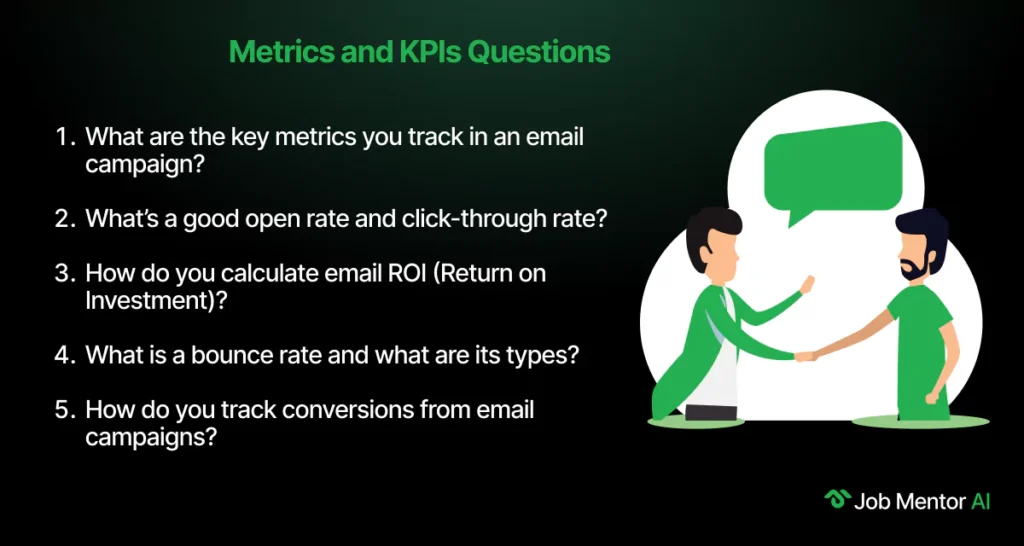
21. What are the key metrics you track in an email campaign?
The key metrics I track in an email campaign are:
- Open rate – how many people opened the email.
- Click-through rate (CTR) – how many clicked on links.
- Bounce rate – how many emails couldn’t be delivered.
- Unsubscribe rate – how many opted out.
- Conversion rate – how many completed the desired action, like a purchase.
These help measure the success of a campaign.
22. What’s a good open rate and click-through rate?
It depends on the industry, but generally:
Open rate: 20–25% is average.
Click-through rate (CTR): 2–5% is good.
Higher rates show that our subject lines and content are engaging your audience.
23. How do you calculate email ROI (Return on Investment)?
ROI = (Revenue from email campaign – Cost of campaign) / Cost of campaign × 100
For example, if you spent $500 and earned $2,000, the ROI is:
(2000–500)/500 × 100 = 300%.
It shows how effective the campaign was in generating income.
24. What is a bounce rate and what are its types?
Bounce rate is the percentage of emails that couldn’t be delivered.
- Soft bounce: Temporary issues like a full inbox.
- Hard bounce: Permanent issues like invalid email addresses.
Too many bounces can harm your sender’s reputation.
25. How do you track conversions from email campaigns?
I use tools like Google Analytics with UTM parameters to track what users do after clicking an email link. I also set up goals in Analytics or use e-commerce tracking to measure things like form submissions or sales.
A/B Testing and Optimization Email Marketing Interview Questions
Optimization through A/B testing is a must-have skill. Interviewers will ask about how you’ve tested different email elements like subject lines, send times, and visuals. These email marketing interview questions are a great opportunity to show how you experiment, analyze results, and use insights to boost campaign performance.
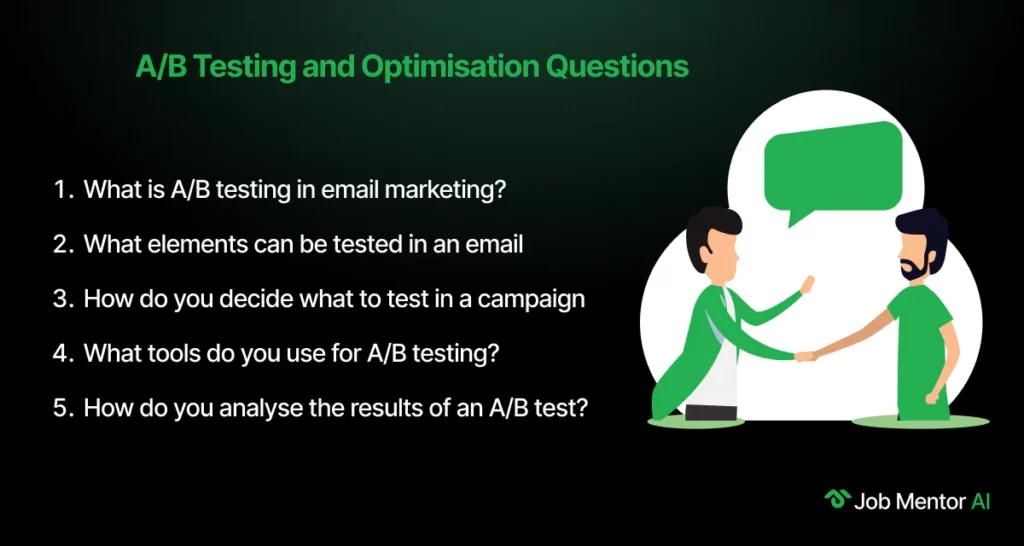
26. What is A/B testing in email marketing?
A/B testing (or split testing) is sending two versions of an email to see which performs better. You change one element (like the subject line or CTA) and compare the results based on open rate, click rate, or conversions.
27. What elements can be tested in an email?
Elements that can be tested in an email are:
- Subject lines
- Sender name
- Email copy or tone
- CTA buttons
- Images
- Send time and day
Testing helps improve engagement and understand what your audience prefers.
28. How do you decide what to test in a campaign?
I start by identifying the weakest area. If open rates are low, I test subject lines. If click rates are low, I test CTAs or content. I make sure to test one element at a time to get clear results.
29. What tools do you use for A/B testing?
Many email marketing platforms like Mailchimp, Klaviyo, HubSpot, and ActiveCampaign have built-in A/B testing features. I also use Google Analytics to track the behaviour after the user clicks through.
30. How do you analyse the results of an A/B test?
I compare performance metrics like open rate, click rate, and conversions. I look at statistical significance to be sure the difference isn’t just random. Once I find a winner, I apply the learnings to future campaigns.
Enhance Your Interview Preparation with AI Interview Assistant
Want to sharpen your skills before the big day? An AI interview assistant can help you prepare for tough email marketing interview questions with realistic simulations.
Use tools like AI mock interview practice and an AI interview answer generator to get personalized feedback and boost your confidence. It’s like having a coach in your corner anytime, anywhere.
Email Marketing Interview Questions to Ask the Interviewer
- What email marketing tools and platforms does your company use?
- How large is your current email list, and how often do you clean it?
- What are the main goals of your email marketing strategy?
- How does the team stay updated with changes in email marketing trends?
- What would success look like in the first 90 days for this role?
30 Email Marketing Interview Questions For 2025
Table of Contents
Recommended Resources
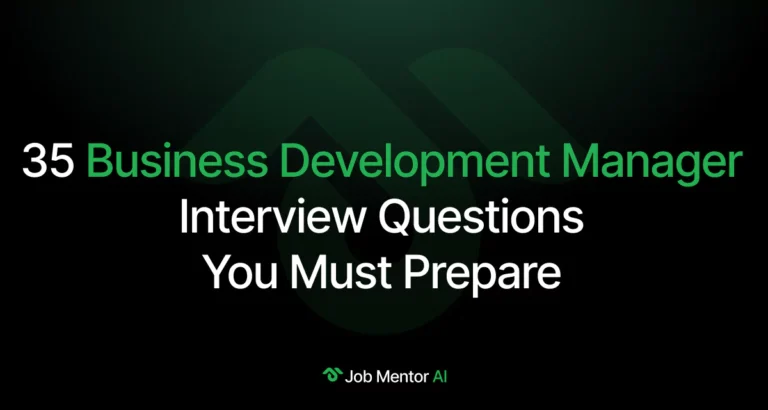
35 Most Common Business Development Interview Questions
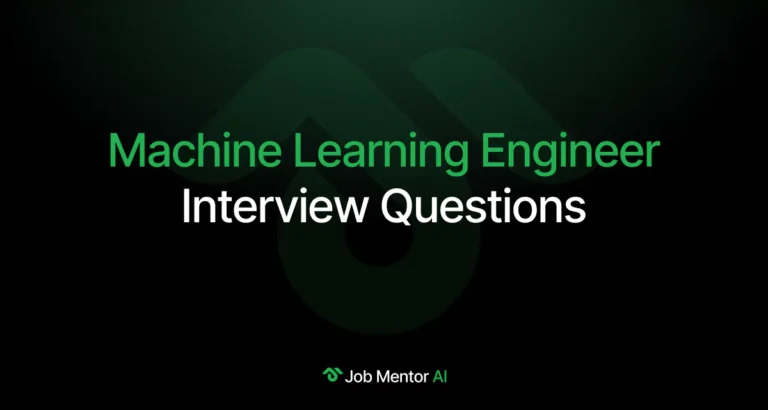
Machine Learning Engineer Interview Questions
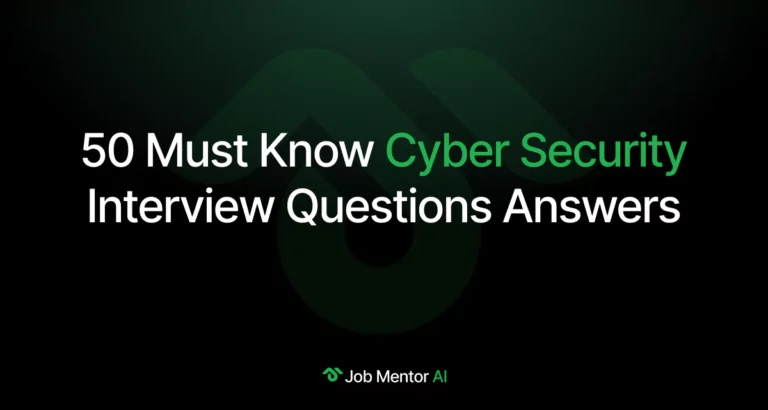
50 Must Know Cyber Security Interview Questions Answers
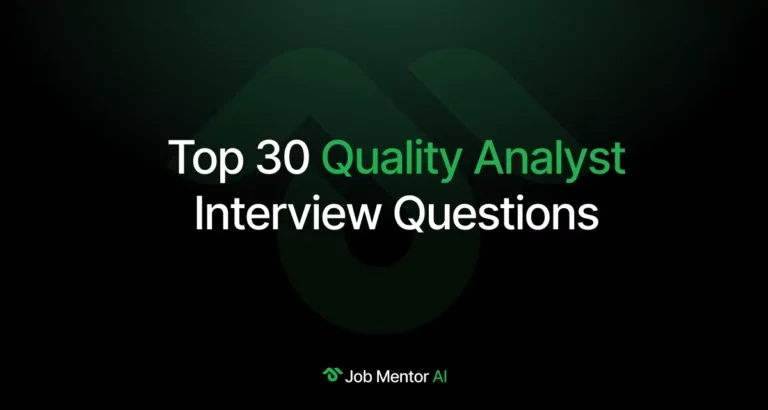
30 QA Interview Questions and Answers for 2025
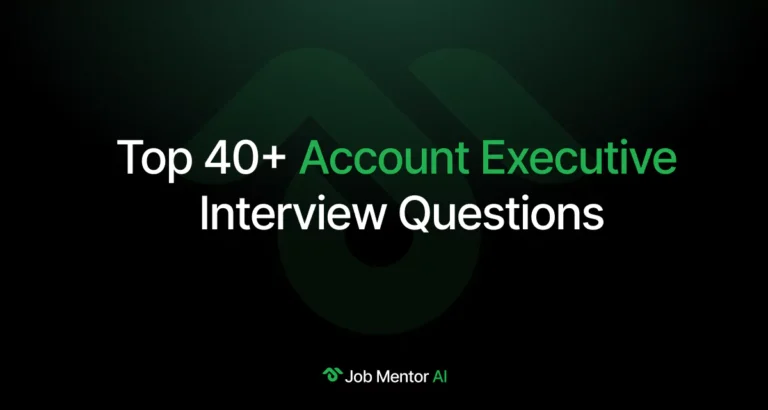
Top 40+ Account Executive Interview Questions
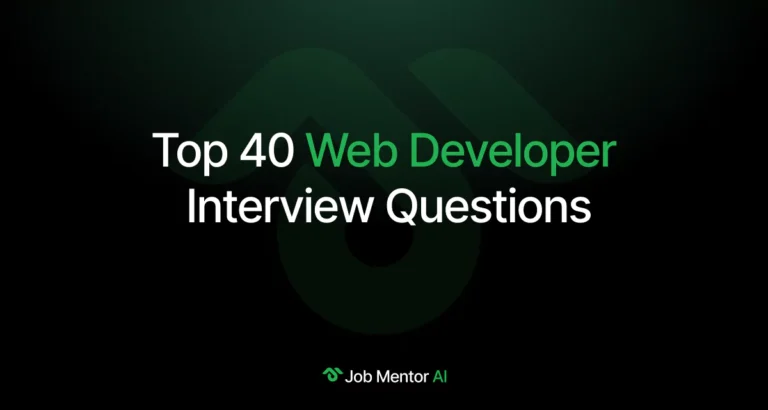
Web Developer Interview Questions


